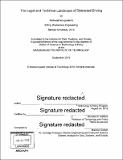| dc.contributor.advisor | Nicholas A. Ashford. | en_US |
| dc.contributor.author | Mongkolsinh, Natharat. | en_US |
| dc.contributor.other | Massachusetts Institute of Technology. Institute for Data, Systems, and Society. | en_US |
| dc.contributor.other | Technology and Policy Program. | en_US |
| dc.date.accessioned | 2019-09-17T16:29:19Z | |
| dc.date.available | 2019-09-17T16:29:19Z | |
| dc.date.copyright | 2018 | en_US |
| dc.date.issued | 2018 | en_US |
| dc.identifier.uri | https://hdl.handle.net/1721.1/122202 | |
| dc.description | Thesis: S.M. in Technology and Policy, Massachusetts Institute of Technology, School of Engineering, Institute for Data, Systems, and Society, 2018 | en_US |
| dc.description | Cataloged from PDF version of thesis. | en_US |
| dc.description | Includes bibliographical references. | en_US |
| dc.description.abstract | In the year 2016, distracted driving contributed to 9% of fatal crashes, killing 3,450 people in the United States. While non-technological distractions are a significant concern, this thesis focuses on technological activities that have a unique technology-based risk of distraction as well as present a unique possibility for solutions both through technological safe-guards and legal interventions. The activities of focus in this thesis include talking or texting on a mobile phone (both hand-held and hands-free), using a GPS device (in-vehicle and nomadic), and performing like tasks - including emailing and watching videos on fixed in-vehicle devices. The thesis explores the problem of distracted driving through an expensive literature review of the risks involved. This technical understanding lays a foundation for examining the legal response to technological distractions in the vehicle (both from in-vehicle technology and nomadic devices). The thesis explores the legislative landscape in non-U.S. jurisdictions (for example, the UK, the Netherlands, Sweden, Australia, Canada, France), the legislative landscape in U.S. jurisdictions, and state-imposed product liability and failure to warn in the U.S. It also puts forward the existing and possible educational and technological interventions which can complement legal interventions to effectively promote a change in driver behavior and ultimately safer roads. We conclude that the legal system nationally and internationally is not yet up to the challenge that the emerging technology portends. | en_US |
| dc.description.statementofresponsibility | by Natharat Mongkolsinh. | en_US |
| dc.format.extent | 100 pages | en_US |
| dc.language.iso | eng | en_US |
| dc.publisher | Massachusetts Institute of Technology | en_US |
| dc.rights | MIT theses are protected by copyright. They may be viewed, downloaded, or printed from this source but further reproduction or distribution in any format is prohibited without written permission. | en_US |
| dc.rights.uri | http://dspace.mit.edu/handle/1721.1/7582 | en_US |
| dc.subject | Institute for Data, Systems, and Society. | en_US |
| dc.subject | Technology and Policy Program. | en_US |
| dc.title | The legal and technical landscape of distracted driving | en_US |
| dc.type | Thesis | en_US |
| dc.description.degree | S.M. in Technology and Policy | en_US |
| dc.contributor.department | Massachusetts Institute of Technology. Institute for Data, Systems, and Society | en_US |
| dc.contributor.department | Massachusetts Institute of Technology. Engineering Systems Division | |
| dc.contributor.department | Technology and Policy Program | |
| dc.identifier.oclc | 1111801871 | en_US |
| dc.description.collection | S.M.inTechnologyandPolicy Massachusetts Institute of Technology, School of Engineering, Institute for Data, Systems, and Society | en_US |
| dspace.imported | 2019-09-17T16:29:17Z | en_US |
| mit.thesis.degree | Master | en_US |
| mit.thesis.department | ESD | en_US |
| mit.thesis.department | IDSS | en_US |
